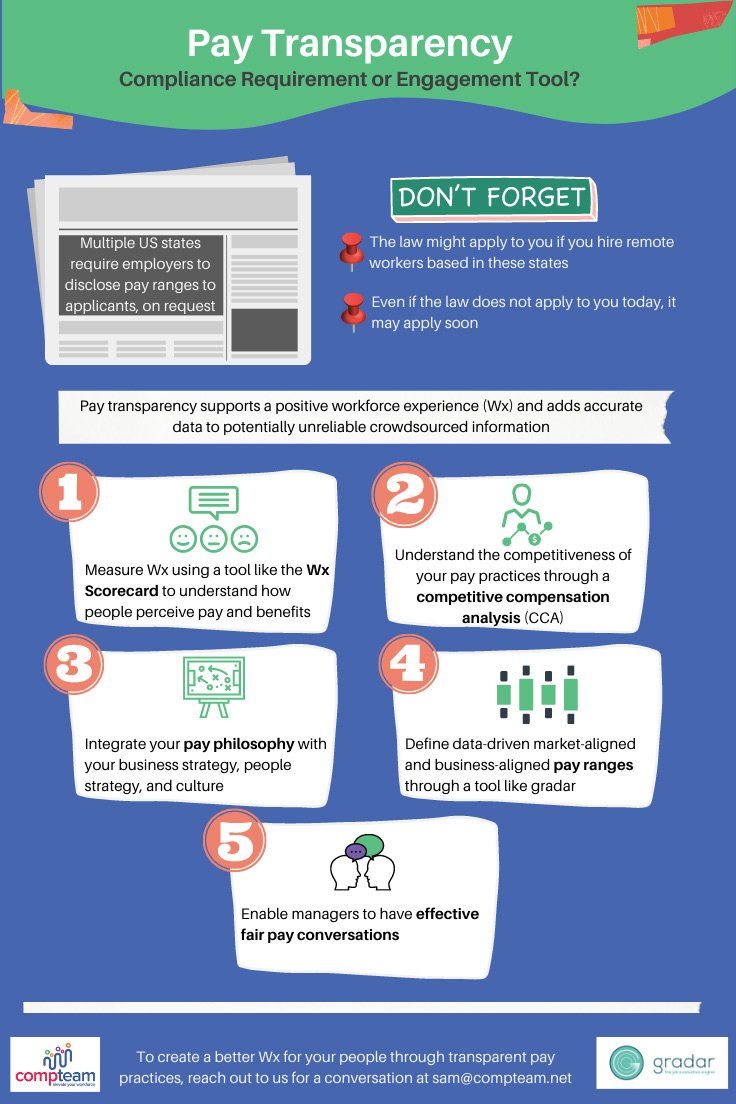Pay Transparency: Compliance Requirement or Engagement Tool?
In a trend that could be terrifying for hiring managers and HR leaders, the clamor for pay transparency is growing across the world. Multiple states in the US require employers to disclose pay ranges to job applicants, upon request. Even if you are not based in these specific states, if you are hiring remote workers, the laws may apply to you. And if they do not apply to you today, they might do so at some point in the future.
The common fear among HR practitioners is that people may find it ‘upsetting’ to see transparently available pay ranges because they would not be able to understand the rationale behind differences in pay. They feel that their pay might not enable them to attract or retain the right kind of talent. Advocates of pay transparency feel that the only reason to keep pay ranges confidential is to keep pay gaps and disparities under wraps.
However, apart from the legal aspects and the need to comply, pay transparency is fast becoming a vital component of the overall workforce experience (Wx). Some part of pay transparency is already out in the open with sites such as Glassdoor and PayScale providing crowdsourced data around pay and pay ranges. LinkedIn also provides salary ranges for some positions. While this data is certainly not as authentic as scientific analyses performed by professionals, it can provide people with a directional sense of pay.
Pay transparency does not necessarily mean sharing of salary details for all employees across the organization. However, by showing the intentionality to have clear pay practices with the following steps, you can address the need for transparency:
1. Measure your Wx using a tool like the Workforce Experience (Wx) Scorecard to decode the way people perceive pay and benefits. Identify the practices that work for them and those that create a negative Wx. Compare the quantitative and qualitative information you collect with publicly available data and earlier employee surveys.
2. Perform a competitive compensation analysis (CCA) to understand the internal and external competitiveness of your current pay practices across job families. Using the point-factor method or another job evaluation methodology to identify the relative worth of jobs within and outside the organization.
3. Articulate your pay philosophy that integrates with your business strategy and people strategy. Include information about the skills and behaviors you would like to reward in your people. Add your employer value proposition (EVP) and the cultural pillars that support your pay practices.
4. Define pay ranges that are business-aligned and market-aligned. With a scientific approach, you can create a legally defensible pay program, which also stays aligned with employee expectations. Ensure that the unique needs of diverse employee groups are addressed and remote workers feel adequately included as well.
5. Enable managers to have clear conversations around pay by setting and managing the right expectations at work. Encourage managers to clearly articulate messaging around pay and pay differentiation so that people understand that pay differences result from performance or competency gaps and not unfair pay practices.

To create a better Wx for your people through transparent pay practices, reach out to us for a conversation at [email protected].
About the Author
Sumit Singla
Founder of eleventHR Consulting.
Sumit has been working in HR & HR consulting roles for 16+
years across sectors and verticals and specializes in
organization design, wellbeing, storytelling & design thinking, and performance management. In his career with consulting firms such as Aon, Deloitte, and Accenture, he has successfully led programs aimed at total HR transformation for clients.
Recently, as Associate Director for India Consulting at Deloitte, he worked with clients on cultural transformation and HR process and policy design. He also organized and spoke at conferences and events about a variety of topics relevant to HR today.
Now self-employed, he works with clients across the globe on a variety of HR solution areas.





